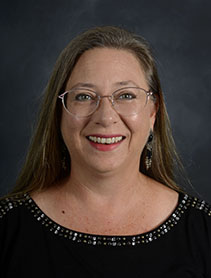
Dr. Lisa Waidner
- Position: Associate Professor
- Department: CEDB/Biology
- Office Location: Building 58, Room 62I
- lwaidner@uwf.edu
- Campus: 850.474.3386
- Personal UWF Website
- Waidner Google Scholar
- Curriculum Vitae (CV)
Biography
Dr. Lisa Waidner, an Associate Professor, has a Ph.D. from the College of Marine Science at the University of Delaware. Before she joined UWF in 2016, Waidner had the unique opportunity to work in several small biotechnology companies, utilizing genetic engineering, phylogenetics, and directed evolution to improve biofuel- and bioenergy-producing microorganisms. Her academic mentors included Richard Karpel (UMBC, M.S. program), David Kirchman (Delaware, Ph.D. program), Thomas Hanson (Delaware, postdoctoral position), and co-mentors Robin Morgan and Joan Burnside (Delaware, postdoctoral fellowship).
Her research is published in a variety of journals, including Journal of Shellfish Research, Enzyme and Microbial Technology, Journal of Industrial Microbiology and Biotechnology, Applied and Environmental Microbiology, Virology, Environmental Virology, and Frontiers in Marine Science, among others. Dr. Waidner’s current research interests are in bioremediation, molecular environmental microbiology, and microbial ecology in oceans, coastal waters, inland bays, and rivers. She continues to mentor and work with undergraduate students in UWF's Biology program and M.S.-seeking students. Undergraduate research projects in her lab are designed to help characterize and better understand the ecology and molecular biology of a variety of bacteria typically found in coastal and inland waters adjacent to the Pensacola Bay system.
Degrees & Institutions
- Ph.D. Marine Studies, University of Delaware
- M.S. Applied Molecular Biology, University of Maryland
- B.S. Biological Sciences, University of Maryland Baltimore County
Current Courses
- Biochemistry
- General Microbiology
- Molecular Aquatic Microbial Ecology (MAME)
Publications
(*, UWF graduate student; **, UWF undergraduate student)
Waidner, L.A., Daniel, C.E., Kovar, S.E., and J.C. Spain. (2024) Monitoring of 2,4-Dinitroanisole Degrading Bacteria in Water and Soil by qPCR. Journal of Industrial Microbiology and Biotechnology.
Matallana-Surget, S., Nigro, L.M., Waidner, L.A., Lebaron, P., Wattiez, R., Werner, J., Fraser, R., Dimitrov, D., Watt, R., and W.H. Jeffrey (2024) Clarifying the Murk: Unveiling Bacterial Dynamics in Response to Crude Oil Pollution, Corexit-Dispersant, and Natural Sunlight in the Gulf of Mexico. Frontiers in Marine Science, 10, Section, Marine Molecular Biology and Ecology.
Plummer, S.M., Plummer, M.A., Merkel, P.A. and L.A. Waidner (2024) Using Directed Evolution to Improve Hydrogen Production in Chimeric Hydrogenases from Algal Species. Enzyme and Microbial Technology, 173:110349.
Waidner, L.A. and T.V. Potdukhe (2023) Tools to Enumerate and Predict Distribution Patterns of Environmental Vibrio Vulnificus and Vibrio Parahaemolyticus. Microorganisms, 11(10):2502.
Headrick*, E.L., Nigro, L.M. Waidner, L.A., Ederington-Hagy, M., Simmering*, A. Richard A. Snyder, R.A. and W.H. Jeffrey (2023) Acute inhibition of bacterial growth in coastal seawater amended with crude oils with varied photoreactivities. Frontiers in Ecology and Evolution, Vol.11;2023/01/04. DOI: https://doi.org/10.3389/fevo.2023.1113899
Potdukhe*, T.V., Caffrey, J.M. Rothfus*, M.J., Daniel*, C.E., Swords**, M.E., III, Albrecht, B.B., Jeffrey, W.H., and Waidner, L.A. (in press) Viable Putative Vibrio vulnificus and parahaemolyticus in the Pensacola and Perdido Bays: Water Column, Sediments, and Invertebrate Biofilms. Front. Mar. Sci., doi: 10.3389/fmars.2021.645755.
Gao, Y.-Z., Palatucci*, M.L., Waidner, L.A., Li, T., Guo, Y., Spain, J.C., and Zhou, N.-Y. (2020) A Nag-like dioxygenase initiates 3,4-dichloronitrobenzene degradation via 4,5-dichlorocatechol in Diaphorobacter sp. strain JS3050. Environ. Microbiol. https://doi.org/10.1111/1462-2920.15295.
Babcock*, K.K., Cesbron, F., Patterson, W.F., Garner, S.B., Waidner, L.A., and Caffrey, J.M. (2020). Changing Biogeochemistry and Invertebrate Community Composition at Newly Deployed Artificial Reefs in the Northeast Gulf of Mexico. Estuaries Coasts 43, 680–692.
Madeira, C.L., K.V. Jog, E.T. Vanover, M.D. Brooks, D.K. Taylor, R. Sierra-Alvarez, L.A. Waidner, J.C. Spain. 2019. Microbial enrichment Culture Responsible for the Complete Oxidative Biodegradation of 3-Amino-1,2,4-triazol-5-one (ATO), the Reduced Daughter Product of the Insensitive Munitions Compound 3-Nitro-1,2,4-triazol-5-one (NTO). Environ. Sci. Technol. 09.25.2019.
Palatucci, M.L., L.A. Waidner, E.E. Mack, J.C.Spain. 2019. Aerobic biodegradation of 2,3- and 3,4-dinitrochlorobenzene. J.Hazardous Materials. 05.31.2019.
Plummer, M., Plummer, S.M., Merkel, P.A., Hagen, M., Biddle, J.F., and L.A. Waidner. 2016. Using directed evolution to improve hydrogen production in chimeric hydrogenases from Clostridia species. Enzyme and Microbial Technology 93 (2016) 132–141. Relevance: Examination of hydrogenase sequence variations with respect to function.
Schab, C.M., Park, S., Waidner, L.A., and Epifanio, C.E. 2013. Return of the Native: Historical Comparison of Invasive and Indigenous Crab Populations near the Mouth of Delaware Bay J. Shellfish Research. 32(3):751-758. Relevance: In-depth statistical analysis of multiple crab species in an entire season of sampling, use of multiple statistical packages.
Jamindar, S., Polson, S.W., Srinivasiah, S., Waidner, L.A., and Wommack, K.E. 2012. Evaluation of two approaches for assessing the genetic similarity of virioplankton populations as defined by genome size. Applied and Environmental Microbiology. 78:8773-8783. Relevance: Examination of complex genomic variation via genetic manipulation and phylogenomics.
Waidner, L.A., Burnside, J., Anderson, A.S., Bernberg, E.L., German, M.A., Meyers, B.C., Green, P.J., and Morgan, R.W. 2011. A microRNA of infectious laryngotracheitis virus can downregulate and direct cleavage of ICP4 mRNA. Virology. 411:25-31. Relevance: Expression manipulation via artificial and viral microRNA introduction into whole-cell systems.
Please visit Publications to see more of L.A. Waidner's research articles.
Keywords: Technical writing, scientific publication, academic and SBIR grant proposal writing, data analysis, statistics, PCR, qPCR, qRT-PCR, standard microbiology and virology culturing processes, anaerobic bacteria (culturing, manipulation and transformation), epifluorescence microscopy, infrared microscopy, confocal microscopy, fluorescence in situ hybridization, flow cytometry, bacterial production (3H-leucine), library construction (plasmid, phage, fosmid, BAC), PFGE, microRNA analyses (small RNA 32P Northern blots, miRNA qRT-PCR, next-generation sequencing of small RNAs), eukaryotic (mammalian, avian, and microalgal) cell culture, Western blotting, conventional and tagged protein chromatography, DGGE population diversity analyses, Chlorobium, Chlorobaculum, Clostridia, Chlamydomonas, Erythrobacter, Roseobacter. Delaware River and estuary system, Chesapeake Bay, Pensacola Bay system


